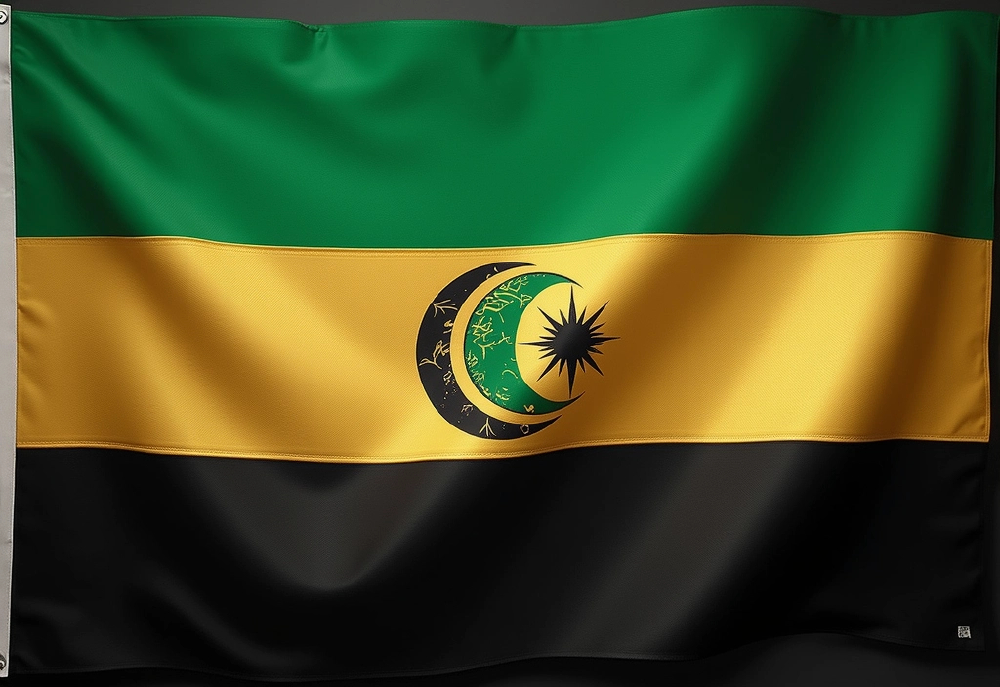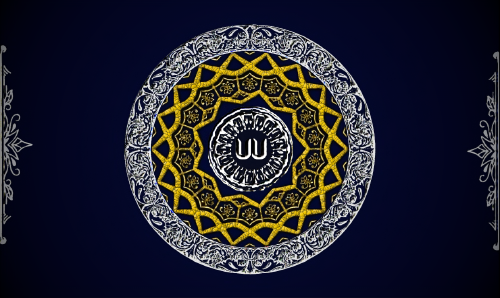This nation is in Vacation Mode for the next 1,443 turns. This nation cannot be attacked or traded with during that time.
The Sultanate of Ibrahim
A nascent nation (11 days old) in the Nile Delta, forged in 2024 from a unification of tribal, Sufi, and colonial-era factions. Its economy hinges on oil, gold, and bauxite, fueling ambitious green-energy projects like solar smelters and mangrove restoration. Despite vast resource wealth, it grapples with mercury pollution, youth unemployment (36%), and reliance on foreign tech. Culturally vibrant, it blends Islamic tradition with grassroots innovation—artisan markets thrive, and interfaith festivals bridge Coptic, Bedouin, and Arab communities.
Leader: Sultan ELKaed Ibrahimx
A former economist and military strategist, Ibrahimx rules as an absolute monarch under the title “Guardian of the Delta’s Lifelines.” He champions Islamic socialism, merging Quranic principles with state-controlled resource nationalism. His policies include universal basic income ($15/month), the Green Jihad (eco-reclamation), and solar infrastructure, yet tolerate moderate social freedoms (women in bureaucracy, hemp legalization). Critics label him a “pharaoh in disguise” for prioritizing elite oil deals over pollution crises.
Ideology: “Enlightened Autocracy”
A fusion of Quranic governance, pan-African solidarity, and eco-socialism. Key tenets:
- Resource Sovereignty: State control of oil/minerals to fund welfare.
- Environmental Stewardship: Quranic mandates for reforestation and solar energy.
- Cultural Unity: Sufi-inspired tolerance, celebrating Nile Delta’s diverse heritage.
Contradictions abound—oil wealth funds green projects while poisoning the delta, and autocratic rule clashes with youth-driven tech reforms. The Sultanate’s motto, “From gold beneath to light above,” encapsulates its gamble: transforming resource curse into sustainable rebirth.
| National Factbook |
| Flag: |

|
| Nation Name: |
Ibrahim |
| Leader Name: |
Ibrahimx |
| Currency: |

Gold Standard |
| National Animal: |

Golden eagle |
| History: |
The Sultanate of Ibrahim
In the fertile Nile Basin and Delta, Sultan ELKaed Ibrahimx seized power in 2024, forging an absolute monarchy that merges Islamic orthodoxy with agrarian socialism. With 398,633 citizens across 5,000 sq. miles of lush farmland and riverine arteries, this 11-day-old nation grapples with ecological collapse and fragile unity.
Governance: Ibrahimx rules as “Guardian of the Delta’s Lifelines,” claiming descent from medieval hydrologists who engineered the delta’s irrigation systems. His capital, Nur-Ali, rises in the eastern delta, its gold-domed palace flanked by sugarcane fields and algae-choked waterways. Nightly Royal Diwans broadcasts frame the Nile as “Allah’s pen writing our destiny,” while dissent brews in the Tadamun movement, which demands democratic reforms in clandestine fishing villages.
Economy: A paradox of far-left policies and river trade. The Gold Standard (1 Dinar = 0.5g gold) funds free healthcare and state-owned cooperatives farming rice and cotton. Yet unregulated factories near Damietta dump toxins into the Nile, turning “the river’s breath” into sludge. The Sultan’s Green Jihad replants 100,000 reeds and sedges to halt erosion, but farmers protest land seizures for “eco-showmanship.”
Crisis & Hope: Nur-Ali’s air reeks of pesticide, yet rural imams preach that “the Nile’s flow mirrors God’s will.” Urban engineers retrofit medieval-era aqueducts with solar pumps, while Sufi dhikr ceremonies bless newly dredged canals. Approval sits at 71.4%, buoyed by UBI rice stipends—though whispers call Ibrahimx a “pharaoh in disguise.”
Future: A ticking clock—can a theocratic monarchy save the delta from saltwater encroachment and Cairo’s shadow? As Ibrahimx vows: “We are the Nile’s answer to those who dammed its voice.”
Stats: Pop. 398,633 | Density 79.73/sq. mile | Motto: “From Mud, We Rise.” |
| Geography |
| Continent: |
Africa |
| Land Area: |
22,530.76 sq. km |
| Terrain: |
Terrain of the Sultanate of Ibrahim
Nestled within the Nile Delta and its adjacent floodplains, the Sultanate of Ibrahim is a tapestry of fertile alluvial soils, labyrinthine waterways, and ecological contrasts. The delta’s flat, low-lying terrain is crisscrossed by the Nile’s distributaries—most notably the Damietta and Rosetta branches—which fan out like veins, nourishing a patchwork of rice paddies, cotton fields, and lotus marshes. Ancient irrigation canals, some dating to medieval hydrologists, thread the land, now retrofitted with solar-powered pumps to combat salinization.
The western delta, in accordance with ancient Egyptian cosmology, hosts arid plateaus once reserved for pharaonic-era burial grounds. These silent necropolises, now eroded by desert winds, overlook brackish wetlands where mangroves battle invasive algae blooms fueled by agricultural runoff. Saltwater encroachment from the Mediterranean has turned northern farmlands into cracked, barren flats.
The eastern delta, home to the capital Nur-Ali, rises into gentle sandy ridges flanked by sugarcane plantations and industrial zones near Damietta, where unregulated factories leach toxins into the river, creating lifeless, sludge-choked waterways. The east—symbolic of rebirth in ancient myth—lacks burial sites, its terrain instead marked by Ottoman-inspired domes and solar-powered aqueducts.
The southern border, near Cairo’s outskirts, boasts the delta’s most fertile farmland—verdant fields of clover and wheat sustained by nutrient-rich silt. Yet even here, the earth bears scars: sinkholes from over-pumped aquifers and abandoned villages swallowed by desertification. Scattered khors (seasonal lakes) provide dwindling refuge for migratory birds.
Urban centers like Nur-Ali blend modern concrete with waterwayside markets, their foundations sinking into waterlogged soil. Transportation relies on narrow dikes and felucca ferries, while the few paved roads buckle under seasonal floods. The terrain’s fragility mirrors the nation’s precarious unity—a land both blessed and cursed by the Nile’s caprices. |
| Highest Peak: |
Gebel Qibli,
612 meters
|
| Lowest Valley: |
Wadi al-Mawta,
-23 meters
|
| Climate: |
Climate of the Sultanate of Ibrahim
The Sultanate endures a Mediterranean-adapted hot desert climate, marked by scorching, arid summers (May–October) with temperatures exceeding 40°C (104°F) inland, moderated slightly near the coast by humidity from the Mediterranean. Winters (November–April) are mild but erratic, with sporadic rainfall (100–200mm annually) often arriving in violent downpours that trigger flash floods in the delta’s fragile canals. Spring brings the khamsin—scorching sandstorms from the Sahara that cloak the sky in orange haze for days, accelerating desertification.
Coastal regions near Damietta suffer high humidity (70–85%) and salt-laden winds that corrode infrastructure and wilt crops. Inland, the delta’s heartland faces extreme diurnal temperature swings, with nights plunging to 10°C (50°F) in winter. Rising sea levels and upstream dams have disrupted the Nile’s natural flood cycle, causing saltwater intrusion that poisons farmland. Pollution from industrial zones exacerbates haze, trapping heat and creating “urban ovens” in cities like Nur-Ali.
The government’s Green Jihad promotes drought-resistant crops and mangrove buffers, but climate models predict a 3°C rise by 2050, threatening to drown the delta’s eastern third. Life revolves around the river’s rhythms: fishermen time hauls to avoid midday heat, while Sufi festivals pray for rain under star-choked skies. |
| People & Society |
| Population: |
663,873 people |
| Demonym: |
Ibrahimi |
| Demonym Plural: |
Ibrahimis |
| Ethnic Groups: |
Egyptians - 82.0%
Nubians - 12.0%
Bedouin - 6.0% |
| Languages: |
Arabic(MSA) - 89.0%
Nubian - 11.0% |
| Religions: |
Islam - 93.0%
Cobtic - 4.0%
Ibadi - 2.0% |
| Health |
| Life Expectancy: |
67 years |
| Obesity: |
19.3% |
| Alcohol Users: |
4.2% |
| Tobacco Users: |
31.6% |
| Cannabis Users: |
14.7% |
| Hard Drug Users: |
2.1% |
| Economy |
| Description: |
Economy of the Sultanate of Ibrahim
The Sultanate of Ibrahim, a young nation nestled in the Nile Delta, balances ambitious growth with the challenges of a resource-rich yet rapidly evolving economy. While still in its infancy (11 days old), the nation pulses with potential, driven by oil discoveries, cultural resilience, and a bold vision for sustainability.
The Sultanate of Ibrahim
A Snapshot of Economy and Society (11 Days Old)
Core Metrics
GDP: $748.45 million
GNI: $422.58 million
GDP per Capita: $1,877.54
Average Income: 52.35/year(rural)to3,200/year (urban elites)
Trade Balance: +$1.1 billion (oil/gold exports)
Key Economic Sectors
Oil & Mining
Oil Reserves: 2.3 billion barrels (offshore/shale).
Gold: Funds universal basic income ($15/month).
Bauxite: 1.2M tons/year mined; solar smelters at 40% capacity.
Agriculture
Crops: Rice, cotton, sugarcane (salt-tolerant R&D underway).
Aquaponics Hubs: Pilot projects in delta villages.
Renewables & Tech
Solar Jihad Initiative: State solar farms power 30% of cities.
Nur-Ali Innovation District: Youth-led startups in solar tech/hemp textiles.
Major Initiatives
Green Jihad: Mangrove restoration, mercury cleanup (12% progress).
Nur-Ali Solar Refinery: Under construction; aims to cut fuel imports by 2026.
Festival of the Delta: Annual cultural event boosting artisan markets.
Challenges
Pollution: Mercury, oil spills, smelter toxins (9% GDP lost to healthcare costs).
Inequality: Rural vs. urban income gap (1:170 ratio).
Youth Unemployment: 36% (despite mining/construction booms).
Cultural Assets
Artisan Markets: Gold filigree, hemp textiles, Sufi poetry scrolls.
Interfaith Unity: Coptic weavers + Bedouin musicians collaborate at festivals.
Future Goals
2026 Targets:
60% renewable energy mix.
Double aluminum production.
Salt-tolerant rice for 50% of delta farms.
Slogan: “From gold beneath to light above.” |
| Average Yearly Income: |
$47.30 |
| Gross Domestic Product (GDP): |
$3,583,134,421.00 |
| GDP per Capita: |
$5,397.31 |
| Gross National Income (GNI): |
$2,007,827,770.00 |
| Industries: |
Industries of the Sultanate of Ibrahim:
1.Oil/Gas: 2.3B-barrel reserves; exports via Damietta. Employs 8k. Challenges: Fuel imports, spills.
2.Mining: Gold funds UBI ($15/month); mercury pollutes 40% delta. Bauxite (1.2M tons/yr) for solar smelters (180k tons aluminum).
3.Agriculture: 35% workforce. Salt-tolerant rice trials; 12 aquaponics hubs. Threats: Saltwater, pesticides.
4.Renewables: Solar (30% grid); hydrogen R&D. Target: 60% solar by 2026.
5.Aluminum: Solar smelters employ 5k; recycling planned.
6.Artisan: Gold filigree, hemp textiles ($5M sales).
7.Tech/Informal: Solar startups; black markets (12% GDP).
8.Challenges: Pollution (9% GDP loss), 36% youth jobless, foreign dependency.
Initiatives:
* Solar Refinery (2026).
* 50 aquaponics hubs by 2025.
* Mercury cleanup (12%). |
| Military |
| History: |
History
The Ibrahim Armed Forces emerged in 2024 during the nation’s independence, unifying tribal militias, Sufi Brotherhood volunteers, and colonial-era troops into a national defense structure. Their early missions repelled Anglo-French-Israeli coalition airstrikes targeting oil infrastructure, cementing their role as guardians of sovereignty.
Current Structure
Personnel: 40,000 troops (65% conscripts, 35% professional).
Armor: 642 retrofitted T-72/T-55 tanks (desert-adapted with solar optics).
Air Force: 18 non-operational MiG-21s/Sukhoi Su-25s (symbolic deterrence).
Navy: 2 patrol boats guarding Damietta’s oil terminals.
Doctrine & Roles
Priority: Defend oil fields, bauxite mines, and Nile Delta from foreign aggression.
Green Jihad Corps: 5,000 soldiers lead environmental projects (mercury cleanup, reforestation).
Challenges: Outdated equipment; reliance on Russian/Iranian tech to counter Western-Israeli surveillance.
Threats
External: Anglo-French-Israeli coalition blockades and cyberattacks targeting refineries.
Internal: Tadamun insurgents (allegedly funded by foreign actors) sabotage pipelines.
Motto: “The desert shields the faithful.” |
| Soldiers: |
0 |
| Tanks: |
0 |
| Aircraft: |
0 |
| Ships: |
0 |
| Missiles: |
0 |
| Nuclear Weapons: |
0 |
| Last Updated: 04/13/2025 10:21 pm |



















